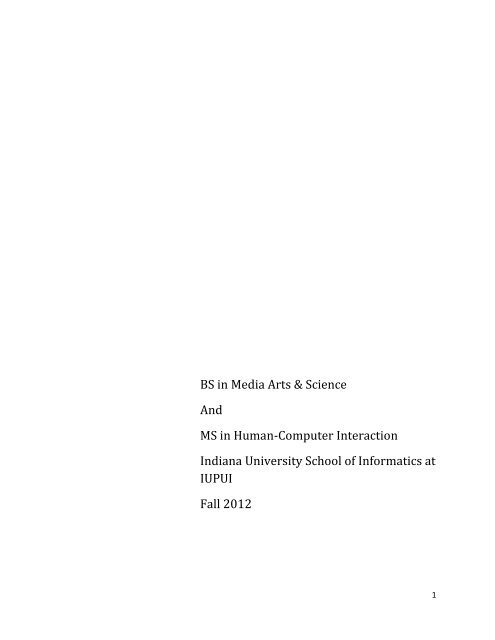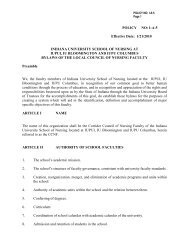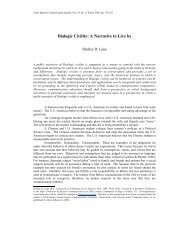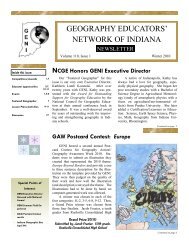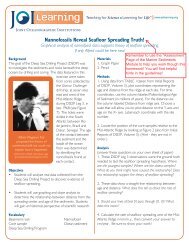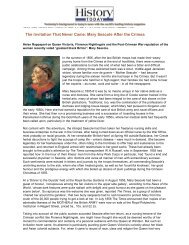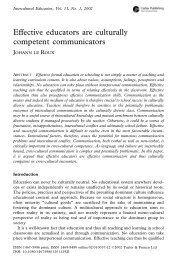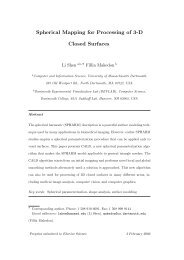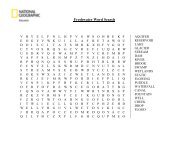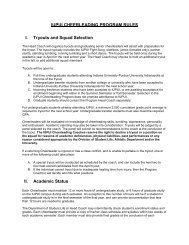BS/MS in Human-Computer Interaction Proposal(PDF - IUPUI
BS/MS in Human-Computer Interaction Proposal(PDF - IUPUI
BS/MS in Human-Computer Interaction Proposal(PDF - IUPUI
Create successful ePaper yourself
Turn your PDF publications into a flip-book with our unique Google optimized e-Paper software.
<strong>BS</strong> <strong>in</strong> Media Arts & Science<br />
And<br />
<strong>MS</strong> <strong>in</strong> <strong>Human</strong>-<strong>Computer</strong> <strong>Interaction</strong><br />
Indiana University School of Informatics at<br />
<strong>IUPUI</strong><br />
Fall 2012<br />
1
Integrated <strong>BS</strong> <strong>in</strong> Media Arts & Science and <strong>MS</strong> <strong>in</strong> <strong>Human</strong>-<strong>Computer</strong><br />
<strong>Interaction</strong><br />
Signature Sheet<br />
Degree Title: Exist<strong>in</strong>g Degrees - <strong>BS</strong> <strong>in</strong> Media Arts & Science and <strong>MS</strong> <strong>in</strong> <strong>Human</strong>-<br />
<strong>Computer</strong> <strong>Interaction</strong>, Indiana University School of Informatics at <strong>IUPUI</strong><br />
Signature of Executive Associate Dean Date<br />
IU School of Informatics at <strong>IUPUI</strong><br />
Signature of Associate Dean for Graduate Studies Date<br />
IU School of Informatics at <strong>IUPUI</strong><br />
Dean of the Graduate School Date<br />
Provost Date<br />
2
<strong>Proposal</strong> Summary<br />
The IU School of Informatics at <strong>IUPUI</strong> proposes an <strong>in</strong>tegrated, five-year, <strong>in</strong>tegrated<br />
<strong>BS</strong><strong>MS</strong> degree program <strong>in</strong> which students will receive both the <strong>BS</strong> <strong>in</strong> Media Arts &<br />
Science and the <strong>MS</strong> <strong>in</strong> <strong>Human</strong>-<strong>Computer</strong> <strong>Interaction</strong>. By design<strong>in</strong>g a seamless<br />
transition from the <strong>BS</strong> <strong>in</strong> Media Arts & Science to the <strong>MS</strong> <strong>in</strong> <strong>Human</strong>-<strong>Computer</strong><br />
<strong>Interaction</strong> curriculum, it is expected that the program will graduate students who<br />
meet all of the requirements for both degrees. The availability of the <strong>in</strong>tegrated-degree<br />
program is also expected to enhance the student recruitment and retention<br />
capabilities of the School. Similar programs currently exist <strong>in</strong> compet<strong>in</strong>g <strong>in</strong>stitutions <strong>in</strong><br />
the U.S.<br />
<strong>IUPUI</strong>’s vision is to be one of the best urban universities, recognized locally, nationally,<br />
and <strong>in</strong>ternationally for its achievements—and already serves as Indiana's premiere<br />
urban research and academic health sciences campus. The campus’ mission is to<br />
advance the State of Indiana and the <strong>in</strong>tellectual growth of its citizens to the highest<br />
levels nationally and <strong>in</strong>ternationally through research and creative activity, teach<strong>in</strong>g<br />
and learn<strong>in</strong>g, and civic engagement. With its strong commitment to teach<strong>in</strong>g and<br />
research, <strong>IUPUI</strong> promotes the educational, cultural, and economic development of<br />
central Indiana and beyond, offer<strong>in</strong>g a dist<strong>in</strong>ctive range of bachelor's, master's,<br />
professional, and Ph.D. degrees.<br />
Consistent with <strong>IUPUI</strong>’s vision and mission, the proposed program will provide<br />
students with <strong>in</strong>tensive tra<strong>in</strong><strong>in</strong>g and opportunities to perform supervised research.<br />
The primary benefit to students is the option to receive two degrees <strong>in</strong> a shorter time<br />
than it would take to pursue the degrees separately. This application proposes a fully<br />
<strong>in</strong>tegrated five-year curriculum, <strong>in</strong>clud<strong>in</strong>g undergraduate and graduate level courses,<br />
which will aid the students <strong>in</strong> develop<strong>in</strong>g a frame of m<strong>in</strong>d and a set of tools that enable<br />
them to apply fundamental <strong>in</strong>formatics pr<strong>in</strong>ciples to solve real-world advanced<br />
application areas. Students who complete the program will have higher credentials<br />
and be able to contribute more quickly and effectively to their employer's mission. The<br />
<strong>in</strong>tegrated 5-year <strong>BS</strong>/<strong>MS</strong> program has several salient features that are attractive to<br />
prospective students; better career opportunities; provides both breadth (<strong>BS</strong>) and<br />
depth (<strong>MS</strong>) of <strong>in</strong>formatics fundamentals and application skill set; better start<strong>in</strong>g salary<br />
upon completion of the program; better career growth opportunity; and, better<br />
prepared to meet the employment opportunities and challenges. Such an <strong>in</strong>novative<br />
program is important for attract<strong>in</strong>g domestic students to graduate studies, especially<br />
from central Indiana and the city of Indianapolis.<br />
3
By its condensed nature, the School of Informatics expects to attract students who are<br />
ready to commit to a serious and <strong>in</strong>tensive course of study. The School expects the<br />
matriculation of these students will serve to enhance the quality of both the<br />
undergraduate and graduate degree programs <strong>in</strong> which they are enrolled. A sample<br />
program of study is <strong>in</strong>cluded at the end of this document.<br />
Degrees to Be Conferred<br />
Successful students will leave this program with two degrees: a <strong>BS</strong> <strong>in</strong> Media Arts &<br />
Science and a(n) <strong>MS</strong> <strong>in</strong> <strong>Human</strong>-<strong>Computer</strong> <strong>Interaction</strong>. These two programs currently<br />
exist.<br />
Rationale and Demand for this Integrated-Degree Program<br />
The Indiana University School of Informatics was the first school of <strong>in</strong>formatics to be<br />
established <strong>in</strong> the United States. As similar programs arise, both with<strong>in</strong> the U.S. and<br />
abroad, the IU School of Informatics is challenged to provide <strong>in</strong>novative strategies to<br />
meet the needs of the chang<strong>in</strong>g education consumer. The five-year <strong>BS</strong>/<strong>MS</strong> program<br />
will provide a seamless <strong>in</strong>tegration of broad-level <strong>in</strong>formation technology background<br />
<strong>in</strong> the <strong>BS</strong> program followed by acquir<strong>in</strong>g a deeper application level understand<strong>in</strong>g<br />
dur<strong>in</strong>g the <strong>MS</strong> course work. This would make our graduates the perfect<br />
“Informaticians,” essentially professionals with a good IT background as well as the<br />
deeper knowledge on how to apply this <strong>in</strong> various application areas rang<strong>in</strong>g from<br />
health sciences to law. The proposed 5-year, <strong>in</strong>tegrated <strong>BS</strong>/<strong>MS</strong> degree program is<br />
expected to attract both the high quality American student respond<strong>in</strong>g to the need to<br />
complete two degrees while m<strong>in</strong>imiz<strong>in</strong>g costs—and to <strong>in</strong>ternational students (who are<br />
similarly) seek<strong>in</strong>g to m<strong>in</strong>imize the considerable costs associated with liv<strong>in</strong>g abroad<br />
while complet<strong>in</strong>g a degree program <strong>in</strong> the United States. The proposed program will<br />
benefit both of these student cohorts while m<strong>in</strong>imiz<strong>in</strong>g the <strong>in</strong>vestment of time and<br />
f<strong>in</strong>ancial resources necessary to fulfill the degree requirements.<br />
Objectives of the Integrated-Degree Program<br />
The proposed <strong>in</strong>tegrated-degree program will provide both <strong>in</strong>tensive education and<br />
supervised research opportunities to high quality students who are serious about<br />
committ<strong>in</strong>g to this unique program. The students will receive two degrees <strong>in</strong> a<br />
relatively shorter time period than it would take to pursue the degrees separately. The<br />
proposed program will help the IU School of Informatics to recruit and reta<strong>in</strong> superior<br />
students who will receive both <strong>BS</strong> and <strong>MS</strong> degrees <strong>in</strong> five years.<br />
Proposed Program Structure<br />
A. Admission requirement- Students will be admitted to the IU School of Informatics<br />
under the guidel<strong>in</strong>es that currently exist for admitt<strong>in</strong>g traditional <strong>BS</strong> students. The<br />
sequence of courses that they will take for the first three years will be identical to the<br />
4
courses taken by the traditional Informatics majors. The students will be made aware<br />
of the option to pursue the <strong>in</strong>tegrated-degree program dur<strong>in</strong>g their first year, and<br />
counseled appropriately if they wish to pursue it. It must be emphasized that the<br />
program is not meant for every Informatics student, rather it is <strong>in</strong>tended for those who<br />
demonstrate the capacity (through a track record) to undertake the academic rigor<br />
necessary to be successful <strong>in</strong> the program. Therefore, the School anticipates that only<br />
highly motivated students would be counseled to enter the <strong>in</strong>tegrated degree program.<br />
Students <strong>in</strong>terested <strong>in</strong> apply<strong>in</strong>g for the <strong>in</strong>tegrated-degree program will do so dur<strong>in</strong>g<br />
the sixth semester <strong>in</strong>to their <strong>BS</strong> program.<br />
Candidates for f<strong>in</strong>al admission to the graduate program will be expected to have a.)<br />
successfully and fully completed the degree requirements for the <strong>BS</strong> <strong>in</strong> Media Arts &<br />
Science, b.) met the m<strong>in</strong>imum 3.0 (undergraduate) GPA requirement and c.) received<br />
at least a B grade <strong>in</strong> each of the graduate courses undertaken as part of his/her <strong>BS</strong> plan<br />
of study (see sample plan of study, semesters seven and eight). Admission is selective:<br />
the Graduate Admissions Committee evaluates applicants’ abilities to succeed<br />
academically and their potential to contribute to the program.<br />
B. Degree Requirements – The proposed curriculum <strong>in</strong>cludes all the core<br />
undergraduate courses that are currently required for Media Arts & Science <strong>BS</strong> majors<br />
and all the current graduate course requirements of the traditional <strong>Human</strong>-<strong>Computer</strong><br />
<strong>Interaction</strong> Master's program.<br />
Students will be required to ma<strong>in</strong>ta<strong>in</strong> a m<strong>in</strong>imum GPA of 3.0 for the first 85 credit<br />
hours of coursework (normally the end of fifth semester) <strong>in</strong> the plan of study <strong>in</strong> order<br />
to be conditionally admitted to the program.<br />
The total credit hours required for this <strong>in</strong>tegrated-degree program will be146 hours<br />
for those students awarded the <strong>BS</strong>/<strong>MS</strong>. For reference, the Bachelor of Science <strong>in</strong> Media<br />
Arts & Science requires 122 hours and the <strong>MS</strong> <strong>in</strong> <strong>Human</strong>-<strong>Computer</strong> <strong>Interaction</strong><br />
requires 36 hours, for a total of 158 hours. The <strong>in</strong>tegrated program is constructed to<br />
exploit overlap economies, thereby reduc<strong>in</strong>g the number of required hours to 146<br />
hours. This reduction <strong>in</strong> the total credit hours is facilitated by allow<strong>in</strong>g the students to<br />
replace 12 hours of General Electives <strong>in</strong> the New Media <strong>BS</strong> plan of study with courses<br />
from the HCI <strong>MS</strong> plan of study.<br />
Successful completion of the graduate program requires at least a B average over all<br />
the courses count<strong>in</strong>g towards the <strong>MS</strong> degree and the student must ma<strong>in</strong>ta<strong>in</strong> a GPA of<br />
3.0. Courses with a grade of C- or less must be taken aga<strong>in</strong> to count towards the <strong>MS</strong><br />
degree. The m<strong>in</strong>imum grade that will be accepted <strong>in</strong> any s<strong>in</strong>gle course is C.<br />
C. Scope and Size of the Program – The program should be attractive to Informatics<br />
students: there have been cont<strong>in</strong>uous <strong>in</strong>quiries on us<strong>in</strong>g the graduate courses taken <strong>in</strong><br />
students' senior years towards their Informatics degrees. Dur<strong>in</strong>g the <strong>in</strong>itial years, it is<br />
5
expected that the program will attract at least five students per year for a period of<br />
four years. This will <strong>in</strong>crease to ten students per year dur<strong>in</strong>g the follow<strong>in</strong>g years. The<br />
first group of students will graduate after the fifth year follow<strong>in</strong>g the start of the<br />
program.<br />
D. Adm<strong>in</strong>istrative Structure – There will be two plans of study for students <strong>in</strong> this<br />
program:<br />
1) a <strong>BS</strong> plan of study that will be filed no later than one semester before complet<strong>in</strong>g the<br />
<strong>BS</strong> degree requirements (normally <strong>in</strong> seventh semester), and will <strong>in</strong>clude the 12 credit<br />
hours of graduate courses to be taken <strong>in</strong> place of the New Media <strong>BS</strong> General Electives<br />
2) an <strong>MS</strong> plan of study that will be completed after the completion of the <strong>BS</strong> plan of<br />
study (normally <strong>in</strong> n<strong>in</strong>th semester).<br />
The two plans of study to be ma<strong>in</strong>ta<strong>in</strong>ed are attached to this document, where the four<br />
overlapp<strong>in</strong>g graduate courses (12 credit hours) are to be <strong>in</strong>dicated <strong>in</strong> both <strong>BS</strong> and <strong>MS</strong><br />
plans. Grant<strong>in</strong>g of the <strong>BS</strong> diploma will be delayed until the <strong>MS</strong> is completed, unless the<br />
student withdraws from the program. A sample plan illustrat<strong>in</strong>g a semester-bysemester<br />
distribution of the courses is also attached.<br />
A m<strong>in</strong>imum GPA of 3.0 will be required <strong>in</strong> the <strong>MS</strong> plan of study for graduation as <strong>in</strong> the<br />
traditional Master's program. Master's GPA will be calculated by <strong>in</strong>clud<strong>in</strong>g the grades<br />
of the two graduate courses undertaken as part of the <strong>BS</strong> plan of study.<br />
The program is designed such that a student <strong>in</strong> the program will be able to switch to<br />
the traditional <strong>BS</strong> <strong>in</strong> Media Arts & Science program at any time to receive a <strong>BS</strong> <strong>in</strong> Media<br />
Arts & Science degree.<br />
The graduate program will offer thesis and non-thesis options. Depend<strong>in</strong>g on the<br />
nature of the research, <strong>in</strong> some cases the thesis option may require an additional<br />
semester to f<strong>in</strong>ish. Thesis committees will consist of at least three faculty from the<br />
<strong>Human</strong>-<strong>Computer</strong> <strong>Interaction</strong> program.<br />
The Graduate Committee will review each student's performance each semester after<br />
they are conditionally admitted to the <strong>in</strong>tegrated-degree program.<br />
Follow<strong>in</strong>g the conditional admission, the student's performance will be assessed by the<br />
Graduate Admissions Committee at the end of each semester to ensure that the<br />
student's performance is at the level expected for traditional <strong>MS</strong> students <strong>in</strong> the HCI<br />
graduate program and the grades <strong>in</strong> each Master's course <strong>in</strong> the <strong>BS</strong> plan of study are B<br />
or higher.<br />
Students will receive both degrees together, upon completion of the requisite credit<br />
hours. As previously described, if a student decides to leave the program, he/she will<br />
still be eligible to receive a <strong>BS</strong> degree. Also, if the student's performance is judged by<br />
the Graduate Committee to be unsatisfactory for the <strong>in</strong>tegrated-degree program <strong>in</strong> that<br />
6
the m<strong>in</strong>imum grade requirements (m<strong>in</strong>imum 3.00 GPA and m<strong>in</strong>imum B grade <strong>in</strong> any of<br />
the first two graduate courses taken) are not met, the student will still be able to<br />
receive a <strong>BS</strong> <strong>in</strong> Media Arts & Science upon completion of all the requirements for that<br />
degree.<br />
This degree program will be offered only on the <strong>IUPUI</strong> campus.<br />
7
IU School of Informatics @ <strong>IUPUI</strong><br />
Bachelor of Science <strong>in</strong> Media Arts and Science<br />
Adopted: Fall 2010<br />
REQUIRED CORE [18 credit hours]<br />
N100 Foundations of New Media 3 _ _ _<br />
N101 Multimedia Author<strong>in</strong>g Tools 3 _ _ _<br />
N102 Digital Media Imagery 3 _ _ _<br />
N202 Digital Storytell<strong>in</strong>g 3 _ _ _<br />
N199 Directed Study I 1 _ _ _<br />
N299 Directed Study II 1 _ _ _<br />
N399 Directed Study III 1 _ _ _<br />
N499 Capstone 3 _ _ _<br />
COMPUTING FOUNDATIONS [3 credit hours]<br />
CSCI N301 Fundamental <strong>Computer</strong> Science Concepts 3 _ _ _<br />
COURSE OF STUDY [57 credit hours. At least 45 credit hours must be NEWM courses, with at least 12 hours at the<br />
300-level and 12 hours at the 400-level. Up to 12 hours may be selected from the list of Selectives]<br />
NEWM _ _ 3 _ _ _<br />
NEWM _ _ 3 _ _ _<br />
NEWM _ _ 3 _ _ _<br />
NEWM _ _ 3 _ _ _<br />
NEWM _ _ 3 _ _ _<br />
NEWM _ _ 3 _ _ _<br />
NEWM _ _ 3 _ _ _<br />
NEWM 3XX _ _ 3 _ _ _<br />
NEWM 3XX _ _ 3 _ _ _<br />
NEWM 3XX _ _ 3 _ _ _<br />
NEWM 3XX _ _ 3 _ _ _<br />
NEWM 4XX _ _ 3 _ _ _<br />
NEWM 4XX _ _ 3 _ _ _<br />
NEWM 4XX _ _ 3 _ _ _<br />
NEWM 4XX _ _ 3 _ _ _<br />
SELECTIVES<br />
INFO Any undergraduate course<br />
HER E101 Beg<strong>in</strong>n<strong>in</strong>g Draw<strong>in</strong>g I<br />
HER E102 Beg<strong>in</strong>n<strong>in</strong>g Draw<strong>in</strong>g II<br />
HER E 103 2D Design<br />
HER E109 Color and Design<br />
HER E214 Visual Learn<strong>in</strong>g<br />
JOUR J152 Sports <strong>in</strong> Society<br />
JOUR J210 Visual Communication<br />
JOUR J320 Creative Advertis<strong>in</strong>g<br />
_ _<br />
_ _<br />
_ _<br />
_ _<br />
_ _ _<br />
_ _ _<br />
_ _ _<br />
_ _ _<br />
CSCI N241 Fundamentals of Web Development<br />
CSCI N341 Client-Side Web Programm<strong>in</strong>g<br />
CSCI N342 Server-Side Web Programm<strong>in</strong>g<br />
CSCI N351 Intro to Multimedia Programm<strong>in</strong>g<br />
CSCI N451 Web Game Development<br />
CIT 21400 Introduction to Data Management<br />
CIT 21500 Web Programm<strong>in</strong>g<br />
CIT 27000 Introduction to Java<br />
CIT 31200 Advanced Web Site Design<br />
CIT 41200 XML-Based Web Applications<br />
8
GENERAL EDUCATION REQUIREMENTS [22 hours]<br />
Learn<strong>in</strong>g Community [INFO I100, 1 credit hour] 1 _ _ _<br />
Written and Oral Communication Skills [9 credit hours]<br />
ENG W131 English Composition l 3<br />
COMM R110 Fundamentals of Speech Communication<br />
Choose one from this list: 3 _ _ _<br />
JOUR J200 Report<strong>in</strong>g, Writ<strong>in</strong>g, and Edit<strong>in</strong>g, or<br />
ENG W132 English Composition II, or 3 _ _ _<br />
TCM 220 Technical Report Writ<strong>in</strong>g<br />
Analytical Skills [6 credit hours] 3 _ _ _ 3 _ _ _<br />
MATH M118 F<strong>in</strong>ite Mathematics PHIL P265 Elementary Symbolic Logic<br />
MATH M153 Algebra and Trigonometry STAT 30100 Elementary Statistical Methods<br />
PHIL P162 Practical Logic STAT 35000 Data Analysis<br />
Arts & <strong>Human</strong>ities [3 credit hours] 3 _ _ _<br />
CLAS C205 Classical Mythology HER H100 Art Appreciation<br />
COMM T130 Introduction to Theatre HER H101 History of Art<br />
ENG L105 Appreciation of Literature MUS M174 Music for the Listener<br />
FILM C292 Introduction to Film PHIL P110 Introduction to Philosophy<br />
FOLK F101 Folklore PHIL P120 Ethics<br />
Social Sciences and Comparative World Cultures [3 credit hours] 3 _ _ _<br />
AFRO A150 Afro-American Studies<br />
POLS Y217 Intro to Comparative Politics<br />
A<strong>MS</strong>T A103 Topics <strong>in</strong> American Studies<br />
POLS Y213 Intro to Public Policy<br />
ANTH A104 Culture and Society PSY B104 Psychology as a Social Science<br />
COMM C180 Interpersonal Communication PSY B310 Life Span Development<br />
GEOG G110 Intro to <strong>Human</strong> Geography SOC R100 Sociology<br />
HIST H105 American History I SOC R121 Social Problems<br />
HIST H108 Perspectives on the World to 1800 REL R133 Introduction to Religion<br />
HIST H113 History of Western Civilization I REL R173 American Religion<br />
HIST H217 The Nature of History REL R212 Comparative Religions<br />
POLS Y101 Pr<strong>in</strong>ciples of Political Science WOST W105 Intro to Women’s Studies<br />
GENERAL ELECTIVES [up to 22 credit hours]<br />
_<br />
_<br />
_<br />
_<br />
_<br />
_<br />
_<br />
_<br />
_<br />
_<br />
_ _ _<br />
_ _ _<br />
_ _ _<br />
_ _ _<br />
_ _ _<br />
_ _ _<br />
_ _ _<br />
_ _ _<br />
_ _ _<br />
_ _ _<br />
Please note that many courses require prerequisites. It is the student’s responsibility to fulfill these requirements.<br />
10.01.2011<br />
9
IU School of Informatics @ <strong>IUPUI</strong> Bachelor of<br />
Science <strong>in</strong> Media Arts and Science<br />
NEWM Courses by Theme<br />
In the new media program students study and practice the use of digital media to communicate, educate,<br />
engage or enterta<strong>in</strong>. The program explores the fundamentals of communication and digital storytell<strong>in</strong>g<br />
and its place today on the desktop, the Web and <strong>in</strong> mobile applications. Many courses <strong>in</strong> the program<br />
are hands-on and project-based, allow<strong>in</strong>g students to become fluent <strong>in</strong> the use of contemporary tools for<br />
produc<strong>in</strong>g Web sites, games, digital illustrations and animations, 3D motion graphics, audio and video.<br />
The program is flexible with a few required courses and lots of choice. Some students develop a passion<br />
for one specialty area, while other students aim to become mixed-media virtuosos. The program also<br />
fosters the skills and qualities prized by employers <strong>in</strong> the 21 st century workplace – skills for<br />
communication, teamwork and productivity.<br />
This list<strong>in</strong>g groups courses related to specialty areas and career goals.<br />
21 st Century Workplace Skills<br />
In addition to the required Directed Study<br />
classes, everyone should consider tak<strong>in</strong>g these<br />
classes.<br />
Storytell<strong>in</strong>g Fundamentals<br />
These classes will help you develop your<br />
writ<strong>in</strong>g, illustration and narrative skills.<br />
Games<br />
Games are great enterta<strong>in</strong>ment, as well as a<br />
powerful medium for market<strong>in</strong>g and education.<br />
In addition to the classes related to Storytell<strong>in</strong>g<br />
and Programm<strong>in</strong>g, the courses listed here are<br />
important for the future game maker.<br />
Web<br />
If you’re <strong>in</strong>terested <strong>in</strong> build<strong>in</strong>g and manag<strong>in</strong>g<br />
Web sites, you should consider these classes.<br />
N 250 TEAM BUILDING IN TECHNOLOGY (P: N202)<br />
N 290 CREATIVE CONCEPT DEVELOPMENT<br />
N 300 DIGITAL MEDIA PRODUCTION (P: N202)<br />
N 385 SEEING SIDEWAYS<br />
N 420 MULTIMEDIA PROJECT DEVELOPMENT<br />
INFO 3XX PROJECT MANAGEMENT<br />
N 201 DESIGN ISSUES IN DIGITAL MEDIA (P: N262)<br />
N 202 DIGITAL STORYTELLING (P: N100)<br />
N 260 SCRIPTWRITING (P: N202)<br />
N 261 STORYBOARDING (P: N101, N102)<br />
N 238 2D ANIMATION (P: N101)<br />
N 241 STOP MOTION ANIMATION<br />
N 285 INTERACTIVE DESIGN (P: N101)<br />
N 332 SEQUENTIAL NARRATIVE (P: N202)<br />
N 432 ADVANCED SEQUENTIAL NARRATIVE (P: N332)<br />
N 438 ADVANCED 2D ANIMATION (P: N238)<br />
N 230 INTRO TO GAME DESIGN & DEV. (P: N221)<br />
N 284 BUILDING PHYSICAL PROTOTYPES<br />
N 330 GAME DESIGN DEV. & PROD. (P: N230)<br />
N 335 CHARACTER DESIGN & ANIMATION (P: N230)<br />
N 431 GAME ON!<br />
N 485 SERIOUS GAMES<br />
N 485 ADVANCED GAME DESIGN<br />
N 215 ON-LINE DOCUMENT DEV. I (P:N101, N102)<br />
N 315 ON-LINE DOCUMENT DEV. II (P: N215)<br />
N 413 ADVANCED WEB (P: N313)<br />
CSCI N241 FUNDAMENTALS OF WEB DEVELOPMENT<br />
10
Programm<strong>in</strong>g<br />
There’s an App for that! Programm<strong>in</strong>g is one<br />
more tool for the digital media professional.<br />
These classes start at the beg<strong>in</strong>n<strong>in</strong>g, but move<br />
quickly to build<strong>in</strong>g rich Internet applications<br />
us<strong>in</strong>g sophisticated programm<strong>in</strong>g concepts.<br />
Audio<br />
Sound is an important addition to any story or<br />
game. These sound classes can be a good<br />
addition to your portfolio of media<br />
understand<strong>in</strong>g and skill.<br />
Video<br />
In these courses you’ll work with advanced<br />
hardware and <strong>in</strong>dustry-standard edit<strong>in</strong>g<br />
software. You’ll work on a variety of videos <strong>in</strong><br />
different video genres <strong>in</strong>clud<strong>in</strong>g <strong>in</strong>terviews,<br />
dramas, documentaries and field productions.<br />
3D GRAPHICS<br />
<strong>Computer</strong>-generated imagery (CGI) is used <strong>in</strong><br />
many places <strong>in</strong>clud<strong>in</strong>g movies, games, virtual<br />
worlds, advertis<strong>in</strong>g, architectural render<strong>in</strong>gs<br />
and scientific illustration.<br />
N 221 MEDIA APPLICATIONS I (P: N101)<br />
N 222 MEDIA APPLICATIONS II (P: N221)<br />
N 321 ACTIONSCRIPT IN 3D (P: N222)<br />
N 322 DYNAMIC DATA APPLICATIONS (P: N222)<br />
N 421 PHYSICAL OBJECT INTERFACES (P: N222)<br />
N 422 ADV. INTERACTIVE PRODUCTION (P: N322)<br />
N 255 INTRO TO DIGITAL SOUND<br />
N 265 SOUND COMPOSITION<br />
N 355 INTERMEDIATE SOUND (P: N255)<br />
N 455 ADVANCED SOUND DESIGN (P: N355)<br />
N 253 INTRO TO DIGITAL VIDEO (P: N202)<br />
N 353 INTERMEDIATE VIDEO (P: N253)<br />
N 356 LIGHTING AND FIELD PRODUCTION (P: N253)<br />
N 357 DIGITAL EFFECTS (P: 253)<br />
N 440 DV AND CGI EFFECTS<br />
N 453 ADVANCED VIDEO<br />
N 243 INTRODUCTION TO 3D<br />
N 342 3D ANIMATION (P: N243)<br />
N 343 3D MODELING (P: N243)<br />
N 344 3D PRODUCTION (P: N342, N343)<br />
N 440 DV & CGI SPECIAL EFFECTS<br />
N 442 ADV 3D ANIMATION TECHNIQUES (P: N342)<br />
N 443 ADVANCED LIGHTING & TEXTURING (P: N243)<br />
N 444 STEREOSCOPIC PROD AND DISPLAY (P: N102)<br />
11
Yr.<br />
1<br />
Yr.<br />
2<br />
MASTER OF SCIENCE<br />
HUMAN-COMPUTER INTERACTION<br />
FULL-TIME STUDENT - PLAN OF STUDY 1<br />
Fall Spr<strong>in</strong><br />
<strong>Interaction</strong> Design Practice (I541)<br />
Mean<strong>in</strong>g and Form g <strong>in</strong> HCI (I561)<br />
>>> (Also called: HCI 1) <strong>Interaction</strong> Design<br />
>>> (Also called: HCI 2)<br />
Methods (I543)<br />
Prototyp<strong>in</strong>g for Interactive Sys (I564)<br />
>>> (Also called: Usability & Eval Methods)<br />
Psychology of HCI (I563)<br />
Research Design (I575) 2<br />
Introduction to Informatics (I501) 5<br />
Advanced Sem<strong>in</strong>ar I <strong>in</strong> HCI (I624) 6<br />
Informatics Research Design (I575) 7<br />
HCI Professional Practice 1 (I680)<br />
Introduction to Informatics (I501) 8<br />
Electives – Arr. 9<br />
HCI Professional Practice 2 (I681)<br />
Summer<br />
Electives –<br />
Arr. 3<br />
Research<br />
Design (I575) 4<br />
Electives – Arr.<br />
– See note<br />
#3.<br />
Project or Thesis Tracks<br />
ALL <strong>MS</strong> HCI students must complete the two course (f<strong>in</strong>al project) option by tak<strong>in</strong>g I680 HCI<br />
Professional Practice 1 and I681HCI Professional Practice 2 <strong>in</strong> their second year, if they are full<br />
time. If they are part time they will eventually need to take these two courses. The Thesis option<br />
is reserved for students who plan to pursue a Ph.D. at a later time or have a strong <strong>in</strong>terest and<br />
demonstrated ability to carry out empirical research (<strong>in</strong> one of the HCI research areas <strong>in</strong>dicated<br />
by a faculty). The Thesis option is required for all fully funded students. Students tak<strong>in</strong>g the<br />
Thesis option MUST take I575.<br />
Note: when we refer to the Two-Course Option (TCO), we refer to the two HCI Professional<br />
Practice courses.<br />
� As noted above, TCO is composed of two courses, three credits each. The courses ars I680<br />
HCI Professional Practice 1 (offered each fall) and I681HCI Professional Practice 2 (offered<br />
each spr<strong>in</strong>g).<br />
� Students will register for each course, which has a formally scheduled class time. Students will<br />
work on one graduation project that extends throughout the two courses. Students will<br />
receive an official grade at the conclusion of each course.<br />
� Students are encouraged to take on a project that can be realistically f<strong>in</strong>ished by the time they<br />
complete both courses. Incompletes will NOT be permitted.<br />
� Students tak<strong>in</strong>g TCO are NOT required to take I575 (Informatics Research Design), which is<br />
reserved primarily for HCI Master’s Thesis students and Ph.D. students. However, TCO students<br />
may take I575 as an Elective. TCO students may also take I624 (HCI Advanced<br />
Sem<strong>in</strong>ar I) as an Elective with permission from the <strong>in</strong>structor.<br />
1<br />
This Plan of Study for HCI <strong>MS</strong> students is based on a full-time schedule. Part-time students will need to take courses as scheduled.<br />
2<br />
I575 Informatics Research Design is ONLY required for students tak<strong>in</strong>g the Thesis option. TCO students may take it as an HCI Elective.<br />
3<br />
Students that take their electives <strong>in</strong> the summer can f<strong>in</strong>ish the program quicker or with less pressure dur<strong>in</strong>g the regular school year<br />
schedule.<br />
4<br />
I575 Informatics Research Design is sometimes offered <strong>in</strong> the summer as well, but varies depend<strong>in</strong>g on enrollment.<br />
5<br />
In the fall semester, students may switch/swap Psychology of HCI for Introduction to Informatics.<br />
6<br />
Advanced Sem<strong>in</strong>ar I is primarily for HCI PhD students, but <strong>MS</strong> students may register for this course.<br />
7<br />
If students desire to take I575, it is better to take it <strong>in</strong> the spr<strong>in</strong>g, first year, but they may also take it <strong>in</strong> the summer (if offered) or fall.<br />
8<br />
Students may take I501 dur<strong>in</strong>g the fall or spr<strong>in</strong>g.<br />
9<br />
Some elective courses may have prerequisites, so students should check with <strong>in</strong>structors from the respective program before en roll<strong>in</strong>g.<br />
12
Recommended Elective Courses<br />
(Students MUST Check for Perquisites & Semester Offered<br />
from the Respective Departments)<br />
I503 Social Impact of Information Tech<br />
I505 Informatics Project Management<br />
I510 Data Acquisition and Lab Automation<br />
I512 Scientific Data Management<br />
I535 Cl<strong>in</strong>ical Information Systems<br />
I540 Data M<strong>in</strong><strong>in</strong>g for Security<br />
I550 Legal & Bus<strong>in</strong>ess Issues <strong>in</strong> Informatics<br />
I554 Independent Study <strong>in</strong> HCI (1-3 cr)<br />
I590 Structured Conceptual Design<br />
I 605 Social Foundations of Informatics<br />
MEDIA ARTS AND SCIENCE<br />
N500 Pr<strong>in</strong>ciples of Digital Arts Production<br />
N502 Digital Media Motion & Sim. Meth<br />
N503 Digital Media Appl Design Proc<br />
N504 Advanced Interactive Design Appl<br />
N506 Media Arts and Technology Project<br />
N510 Web Database Concepts<br />
N501 Foundations of Digital Prod<br />
PSYCHOLOGY<br />
PSY570 Industrial Psychology - Fall, odd yr<br />
PSY572 Organizational Psych – Spg, even yr<br />
PSY615 Physiological Psych - Fall, even yr<br />
PSY640 Social Psychology I - Fall, odd yr<br />
PSY655 Cog Development - Fall, even yr<br />
COMPUTER SCIENCE<br />
CSCI 503 Operat<strong>in</strong>g Systems<br />
CSCI 504 Concepts <strong>in</strong> <strong>Computer</strong> Organ<br />
CSCI 507 Object-Oriented Design & Prog<br />
CSCI 536 Data Comm. & <strong>Computer</strong> Netw<br />
CSCI 537 Intro to Distributed Comput<strong>in</strong>g<br />
ANTH-E404 Field Meth <strong>in</strong> Ethnography<br />
COM 501 Qualitative Research<br />
COM 502 Appld Qualitative Research Methods<br />
EDU 520 Strategies for Educational Inquiry<br />
EDU 611 Qualitative Inquiry <strong>in</strong> Education<br />
NURS-L650 Data Ana for Cl<strong>in</strong> & Adm<strong>in</strong> Dec.-<br />
Mak<strong>in</strong>g<br />
NURS-R612 Interpretive Data Analysis (2 Cr.),<br />
Sum I-II<br />
PSY 600 Statistical Inference (Fall Even Yr)<br />
PSY 601 Experimental Design (Spg Even Yr)<br />
PSY 608 Measurement Theory and Interpret<br />
PSY 640 Survey of Social Psychology I<br />
CSCI 541 Database Systems<br />
CSCI 550 <strong>Computer</strong> Graphics<br />
CSCI 552 Advanced Graphics and Visualization<br />
CSCI 565 Programm<strong>in</strong>g Language<br />
DESIGN (HERRON)<br />
HER–V501 Design Th<strong>in</strong>k<strong>in</strong>g (1.5 cr.) HER–<br />
V502 <strong>Human</strong> Factors <strong>in</strong> Design (1.5 cr.)<br />
HER–R511 Visual Research (3 CR)<br />
COMMUNICATION<br />
COMM-C 500 Advanced Comm Theory<br />
COMM–C 531 Media Theory and Criticism<br />
COMM–C 592 Advanced Health Communication<br />
COMM–C 620 <strong>Computer</strong>-Mediated Communication<br />
SOCIOLOGY<br />
SOC–R 556 Advanced Sociological Theory I<br />
SOC–R 557 Advanced Sociological Theory II<br />
SOC–R 559 Intermediate Sociological Statistics<br />
SOC–R 593 Applied Fieldwork for Sociologists<br />
SOC–S 530 Introduction to Social Psychology<br />
GEOGRAPHY<br />
GEOG–G 536 Advanced Remote Sens<strong>in</strong>g<br />
GEOG–G 537 <strong>Computer</strong> Cartography and Graphics<br />
GEOG–G 538 Intro to Geographic Information Systems<br />
GEOG–G 539 Advanced Geographic Information Systems<br />
OTHERS<br />
ANTH 501 Fundamentals of Applied Anthropology<br />
ED 531 <strong>Computer</strong>s <strong>in</strong> Education<br />
SLIS-S 532 INFO Architecture for the Web<br />
Recommended Research Methods Courses<br />
(Students MUST Check for Perquisites & Semester Offered<br />
from the Respective Departments)<br />
PSY 655 Cognitive Develpmnt (Fall Even Yr)<br />
PSY-I 643 Field Methods & Exper<br />
SOC-R 551 Quantitative Methods – Sociology<br />
SOC-R 551 Quantitative Methods Sociology<br />
SOC-R 559 Intermediate Soc Statistics<br />
STAT 511 Statistical Methods 1<br />
STAT 512 Applied Regression Analysis<br />
STAT 516 Basic Probability Appl<br />
STAT 519 Intro to Probability<br />
STAT 521 Statistical Comput<strong>in</strong>g<br />
STAT-522 Sampl<strong>in</strong>g and Survey Techniques<br />
STAT 524 Applied Multivariate Analysis<br />
STAT 525 Intermediate Stat Methodology<br />
STAT 529 Applied Dec Thry and Bayesian Stat<br />
STAT 619 Probability Theory<br />
13
5 Yr Plan of Study - <strong>BS</strong> MAS - <strong>MS</strong> HCI<br />
Credit hours: 146<br />
colors: General Ed Requirements, MAS <strong>BS</strong> required courses, MAS course of study (at least 45 hours of NEWM + 12<br />
hours of Selectives), HCI <strong>MS</strong> required courses, HCI <strong>MS</strong> electives<br />
1ST SEM. (Fall) 3RD SEM. (Fall) 5TH SEM. (Fall) 7TH SEM. (Fall) 9TH SEM. (Fall)<br />
INFO I100 (1st<br />
Year Experience) 1<br />
NEWM N100<br />
Foundations of<br />
New Media 3<br />
NEWM N101<br />
Multimedia<br />
Author<strong>in</strong>g Tools 3<br />
Math 3<br />
NEWM N299<br />
Directed Study II 1<br />
NEWM/NEWM<br />
SELECTIVE 3<br />
NEWM/NEWM<br />
SELECTIVE 3<br />
CSCI N301 Fund.<br />
CSCI Concepts 3<br />
ENG W131 3 JOUR/ENG/TCM 3<br />
NEWM/NEWM<br />
SELECTIVE 3<br />
NEWM/NEWM<br />
SELECTIVE 3<br />
NEWM/NEWM<br />
SELECTIVE 3<br />
NEWM/NEWM<br />
SELECTIVE 3<br />
NEWM/NEWM<br />
SELECTIVE 3<br />
I501 Intro to<br />
Informatics (<strong>in</strong><br />
place of UG Gen<br />
Elective) 3<br />
I563 Psych of HCI<br />
Arts &<br />
<strong>Human</strong>ities<br />
NEWM/NEWM<br />
3<br />
(<strong>in</strong> place of UG Gen<br />
Elective) 3<br />
SELECTIVE 3 HCI ELECTIVE 3<br />
NEWM/NEWM NEWM/NEWM<br />
SELECTIVE 3 SELECTIVE 3<br />
I564 Prototyp<strong>in</strong>g<br />
for Interactive<br />
Sys. 3<br />
I543 Usability and<br />
Evaluative<br />
Methods 3<br />
I680 HCI<br />
Professional<br />
Practice 1 3<br />
Semester total: 16 Semester total: 16 Semester total: 15 Semester total: 15 Semester Total: 9<br />
2ND SEM. (Spr) 4TH SEM. (Spr) 6TH SEM. (Spr) 8TH SEM. (Spr) 10TH SEM. (Spr)<br />
NEWM N199<br />
Directed Study I 1<br />
NEWM N102 Dgtl<br />
Media Imagery 3<br />
NEWM N202 Dgtl<br />
Storytell<strong>in</strong>g 3<br />
Math 3<br />
COMM R110<br />
NEWM/NEWM<br />
3<br />
SELECTIVE 3<br />
NEWM/NEWM NEWM/NEWM NEWM N499<br />
I681 - HCI Prof<br />
SELECTIVE 3 SELECTIVE 3 Capstone 3 Pract 2 3<br />
I561 HCI Design II<br />
NEWM/NEWM<br />
SELECTIVE 3<br />
NEWM/NEWM<br />
SELECTIVE 3<br />
(<strong>in</strong> place of UG Gen<br />
Elect)<br />
I541 <strong>Interaction</strong><br />
3 HCI ELECTIVE 3<br />
Design Practice<br />
Social Science/<br />
World Culture<br />
NEWM/NEWM<br />
3<br />
NEWM/NEWM<br />
SELECTIVE 3<br />
(<strong>in</strong> place of UG Gen<br />
Elect) 3 HCI ELECTIVE 3<br />
SELECTIVE 3 General Elective 3 HCI ELECTIVE 3<br />
NEWM/NEWM<br />
NEWM/NEWM<br />
SELECTIVE 3 General Elective<br />
NEWM N399<br />
1 SELECTIVE 3<br />
Directed Study III 1<br />
Semester Total: 16 Semester Total: 15 Semester Total: 14<br />
Summer Summer Summer<br />
General Elective 3<br />
General Elective 3<br />
Semester Total: 15 Semester Total: 9<br />
Summer Summer<br />
Semester total 0 Semester Total 0 Semester Total 6 Semester Total 0 Semester Total 0<br />
Year-by-year totals Year-by-year totals Year-by-year totals Year-by-year totals Year-by-year totals<br />
32<br />
31<br />
35<br />
30<br />
18
Susta<strong>in</strong>ability and Impact on the State and Region<br />
The proposed program requires no additional resources and f<strong>in</strong>ancial support from the<br />
school and campus. The key to the success of the program is to make students (prospective<br />
students) aware of the availability of the program when they enter the undergraduate<br />
Informatics program. The seamless transition from undergraduate to graduate programs<br />
will greatly reduce the time needed to complete the two degrees when compared to<br />
traditional, separate <strong>BS</strong> and <strong>MS</strong> degree programs. This proposed program is, therefore,<br />
economical and susta<strong>in</strong>able <strong>in</strong> the long run.<br />
As our city, state and nation move towards a technology-based, high-tech economy, we<br />
cont<strong>in</strong>ue to see a critical need for well-educated, tra<strong>in</strong>ed, high quality Informaticists with<br />
advanced graduate degrees. We fully expect these program graduates with advanced<br />
degrees to have a major impact on central Indiana, the state of Indiana and the greater<br />
Midwest.<br />
Staff<strong>in</strong>g and Infrastructure- Because the program utilizes exist<strong>in</strong>g courses, faculty,<br />
and facilities, no additional resources are required.


